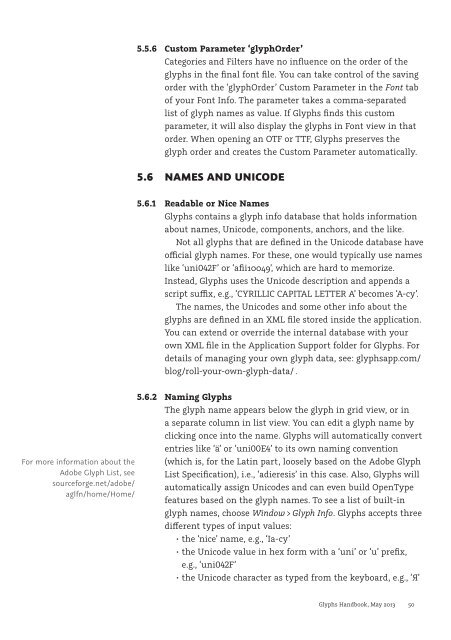Create successful ePaper yourself
Turn your PDF publications into a flip-book with our unique Google optimized e-Paper software.
For more information about the<br />
Adobe Glyph List, see<br />
sourceforge.net/adobe/<br />
aglfn/home/Home/<br />
5.5.6 Custom Parameter ‘glyphOrder’<br />
Categories and Filters have no influence on the order of the<br />
glyphs in the final font file. You can take control of the saving<br />
order with the ‘glyphOrder’ Custom Parameter in the Font tab<br />
of your Font Info. The parameter takes a comma-separated<br />
list of glyph names as value. If <strong>Glyphs</strong> finds this custom<br />
parameter, it will also display the glyphs in Font view in that<br />
order. When opening an OTF or TTF, <strong>Glyphs</strong> preserves the<br />
glyph order and creates the Custom Parameter automatically.<br />
5.6 NAMES AND UNICODE<br />
5.6.1 Readable or Nice Names<br />
<strong>Glyphs</strong> contains a glyph info database that holds information<br />
about names, Unicode, components, anchors, and the like.<br />
Not all glyphs that are defined in the Unicode database have<br />
ocial glyph names. For these, one would typically use names<br />
like ‘uni042F’ or ‘afii10049’, which are hard to memorize.<br />
Instead, <strong>Glyphs</strong> uses the Unicode description and appends a<br />
script sux, e.g., ‘CYRILLIC CAPITAL LETTER A’ becomes ‘A-cy’.<br />
The names, the Unicodes and some other info about the<br />
glyphs are defined in an XML file stored inside the application.<br />
You can extend or override the internal database with your<br />
own XML file in the Application Support folder for <strong>Glyphs</strong>. For<br />
details of managing your own glyph data, see: glyphsapp.com/<br />
blog/roll-your-own-glyph-data/ .<br />
5.6.2 Naming <strong>Glyphs</strong><br />
The glyph name appears below the glyph in grid view, or in<br />
a separate column in list view. You can edit a glyph name by<br />
clicking once into the name. <strong>Glyphs</strong> will automatically convert<br />
entries like ‘ä’ or ‘uni00E4’ to its own naming convention<br />
(which is, for the Latin part, loosely based on the Adobe Glyph<br />
List Specification), i.e., ‘adieresis’ in this case. Also, <strong>Glyphs</strong> will<br />
automatically assign Unicodes and can even build OpenType<br />
features based on the glyph names. To see a list of built-in<br />
glyph names, choose Window > Glyph Info. <strong>Glyphs</strong> accepts three<br />
dierent types of input values:<br />
<br />
<br />
e.g., ‘uni042F’<br />
<br />
<strong>Glyphs</strong> <strong>Handbook</strong>, May <strong>2013</strong> 50


